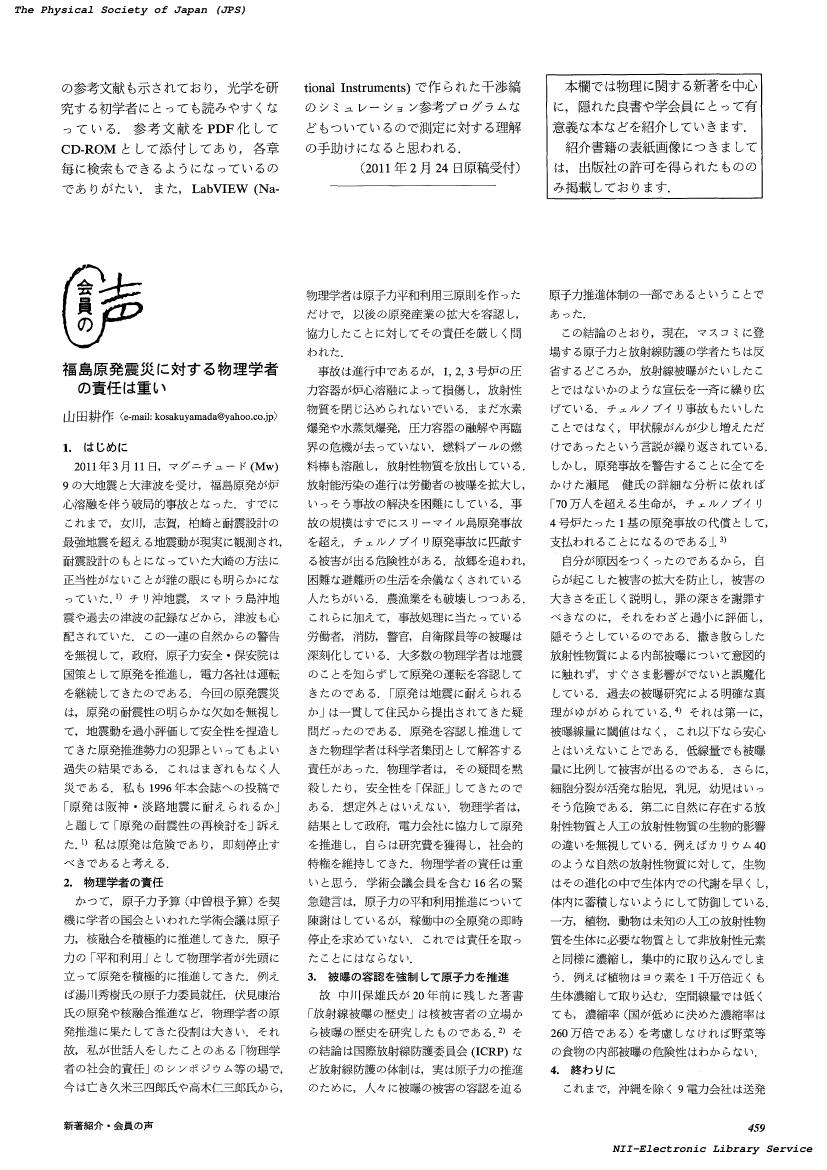1 0 0 0 OA 福島原発震災に対する物理学者の責任は重い(会員の声)
- 著者
- 山田 耕作
- 出版者
- 一般社団法人 日本物理学会
- 雑誌
- 日本物理学会誌 (ISSN:00290181)
- 巻号頁・発行日
- vol.66, no.6, pp.459-460, 2011-06-05 (Released:2018-08-08)
- 著者
- 加藤 康子
- 出版者
- 文化経済学会<日本>
- 雑誌
- 文化経済学 (ISSN:13441442)
- 巻号頁・発行日
- vol.14, no.2, pp.46-54, 2017-09
- 著者
- 田中 智朗 阿部 大輔
- 出版者
- 公益社団法人 日本都市計画学会
- 雑誌
- 日本都市計画学会関西支部研究発表会講演概要集 (ISSN:1348592X)
- 巻号頁・発行日
- vol.19, pp.29-32, 2021 (Released:2021-07-24)
- 参考文献数
- 8
本研究では、コミュニティ型暫定利用を対象に、空地活用の実態を把握した。 以上から、①事業の目的、用途、面積、期間は、運営形態によって傾向が異なること、②暫定利用終了後は対象地 や運営主体の変更が生じるなど新たな展開の契機となる可能性があること③暫定利用を通して場を共有することに よって形成されたコミュニティが、利用終了後も継続的なまちづくり活動として展開されている可能性があること、 が明らかとなった。コミュニティ型暫定利用は終了を前提とした事業であり、いずれ人々の拠点としての場は消滅するが、地域のコ ミュニティ形成に及ぼした影響には持続性を持つ可能性があると考えられる。
1 0 0 0 IR 看護大学生に対する清潔間欠自己導尿指導のシミュレーション演習の評価
- 著者
- 古川 智恵 森 京子
- 出版者
- ヒューマンケア研究学会
- 雑誌
- ヒューマンケア研究学会誌 (ISSN:21872813)
- 巻号頁・発行日
- vol.9, no.2, pp.83-87, 2018
本研究の目的は,看護大学生の学びのレポートから清潔間欠自己導尿指導のシミュレーション演習の評価を行うことである.研究への同意が得られた81 名の学生の演習終了後のレポートを分析対象とした.その結果,【正しい手順を理解するために患者の状況を見ながら根拠を踏まえたわかりやすい指導を行う必要性】,【看護師の温かく見守る態度やよき相談者として信頼関係を築く関わり】など6 カテゴリーが形成された.演習を通して学生は,患者または看護師の立場に立って排尿障害のため清潔間欠自己導尿を行いながら生活する患者の指導方法や苦痛について学んでおり,清潔間欠自己導尿指導のシミュレーション演習は,看護大学生にとって患者理解を学ぶ効果的な演習方法の一つであると言える.
- 著者
- Yuya Ide Hisashi Ogawa Kenjiro Ishigami Syuhei Ikeda Kosuke Doi Yasuhiro Hamatani Akiko Fujino Yoshimori An Mitsuru Ishii Moritake Iguchi Nobutoyo Masunaga Masahiro Esato Hikari Tsuji Hiromichi Wada Koji Hasegawa Mitsuru Abe Gregory Y.H. Lip Masaharu Akao for the Fushimi AF Registry Investigators
- 出版者
- The Japanese Circulation Society
- 雑誌
- Circulation Reports (ISSN:24340790)
- 巻号頁・発行日
- vol.3, no.11, pp.629-638, 2021-11-10 (Released:2021-11-10)
- 参考文献数
- 19
- 被引用文献数
- 2
Background:The ELDERCARE-AF trial demonstrated that low-dose edoxaban prevented stroke or systemic embolism (SE) in very elderly Japanese patients with non-valvular atrial fibrillation (NVAF) in whom standard oral anticoagulant therapy was inappropriate because of high bleeding risk. The aim of this study was to elucidate the characteristics and outcomes of such patients in routine clinical practice.Methods and Results:Data were extracted from the Fushimi AF Registry for ELDERCARE-eligible NVAF patients aged ≥80 years, with a CHADS2score ≥2 and ≥1 bleeding risk factors, as shown in the ELDERCARE-AF trial. ELDERCARE-eligible patients (n=549; 12.8% of the entire cohort, 52.9% of those aged ≥80 years and with CHADS2score ≥2) were less often male, were older, had more comorbidity and higher risk scores than non-eligible patients from the entire cohort (n=3,734). The crude incidence (% per patient-year) of adverse events was significantly higher in ELDERCARE-eligible than non-eligible patients (stroke/SE, 4.8% vs. 2.0%; major bleeding, 3.6% vs. 1.9%; all-cause mortality, 15.5% vs. 3.9%; cardiovascular death, 2.7% vs. 0.6%; all log-rank P<0.001). Compared with non-eligible patients aged ≥80 years and with a CHADS2score ≥2 (n=488), the incidence of stroke/SE, all-cause mortality, and cardiovascular death remained significantly higher in ELDERCARE-eligible patients.Conclusions:Patients with NVAF who met the inclusion criteria of the ELDERCARE-AF trial were common in routine clinical practice, and had poor clinical outcomes.
1 0 0 0 OA オーラルヒストリー伊藤圭一 : [元内閣国防会議事務局長
- 雑誌
- C.0.E.オーラル・政策研究プロジェクト
- 巻号頁・発行日
- 2003-09
インタビュー対象者 : 伊藤 圭一 (イトウ ケイイチ)
- 著者
- 鹿園 直建 原田 広康 池田 則生 柏木 洋彦
- 出版者
- 一般社団法人 日本鉱物科学会
- 雑誌
- 岩石鉱物科学 (ISSN:1345630X)
- 巻号頁・発行日
- vol.38, no.5, pp.149-160, 2009 (Released:2009-11-26)
- 参考文献数
- 20
- 被引用文献数
- 3 3
Dissolution kinetics model calculations were performed for the interaction between three types of basaltic rocks in Japan (Fuji and Hachijyojima fresh basalts and Kitamatsuura altered basalt) and groundwater injected CO2. Dissolution rates of the basalts experimentally determined by the authors (Shikazono et al., 2008) and database of dissolution rate constants of silicate minerals in the basaltic rocks in PATHARC (Talman et al., 2000) were used for the calculations. The results of calculations indicate that most of dissolved carbon in groundwater injected CO2 can be fixed as carbonates in long-term period. The efficiency of carbon fixation is in an order, Hachijyojima>Fuji>Kitamatsuura. But the efficiency is not so different for three basaltic rocks in the fixation of carbon in underground sequestration of CO2. It is inferred that mineral trapping of CO2 by carbonates in basalt aquifer is useful for the long-term fixation of carbon in underground sequestration of CO2.
1 0 0 0 OA いも一切料理法 : 家庭実用
1 0 0 0 OA [朝鮮総督府]調査資料
- 出版者
- 朝鮮総督府
- 巻号頁・発行日
- vol.第24輯 朝鮮の災害, 1935
1 0 0 0 OA 官報
- 著者
- 大蔵省印刷局 [編]
- 出版者
- 日本マイクロ写真
- 巻号頁・発行日
- vol.1948年04月26日, 1948-04-26
1 0 0 0 OA 砥部川水系における土地利用と環境の相互作用
- 著者
- 松濤 一平
- 出版者
- 日本陸水学会
- 雑誌
- 日本陸水学会 講演要旨集 日本陸水学会第70回大会 大阪大会
- 巻号頁・発行日
- pp.95, 2005 (Released:2006-09-07)
1 0 0 0 IR 図書館報. 第116号
- 著者
- 奈良教育大学附属図書館
- 出版者
- 奈良教育大学附属図書館
- 雑誌
- 図書館報
- 巻号頁・発行日
- no.116, 1977-05
図書館利用状況/新着図書案内/文献複写サービスご利用のお勧め
1 0 0 0 OA 三島由紀夫「地獄変」論 : 劇化の経緯をめぐって
- 著者
- 木谷 真紀子
- 出版者
- 同志社大学国文学会
- 雑誌
- 同志社国文学 = Doshisha Kokubungaku (ISSN:03898717)
- 巻号頁・発行日
- no.49, pp.53-64, 1999-01
1 0 0 0 OA 1軸性ひずみによる物性制御
- 著者
- 鹿児島 誠一 前里 光彦 加賀 保行 近藤 隆祐
- 出版者
- 一般社団法人 日本物理学会
- 雑誌
- 日本物理学会誌 (ISSN:00290181)
- 巻号頁・発行日
- vol.54, no.12, pp.969-974, 1999-12-05 (Released:2008-04-14)
- 参考文献数
- 17
さまざまな物性が演じられる舞台は, 原子や分子の配列が作る物質構造である. これを変化させる新たな手段として, 1軸性ひずみの方法を開発した. 装置の基本構造を示し, これによって作られる物質のひずみが1軸性であることを検証する. 実際の研究への適用例として, 2種類の2次元性有機導体の電子状態に与える1軸性ひずみの効果を紹介する. 有機導体に限らず多くの物質において, 1軸性ひずみは, 静水圧や従来の1軸性加圧では実現できない新たな物質構造をもたらす. この実験手法によって, 新規な物性の発見が期待できる.
1 0 0 0 OA マルクスの隠れ家の背後ヘ : 資本主義の概念の拡張のために
- 著者
- フレイザー ナンシー 竹田 杏子[訳]
- 出版者
- 法政大学大原社会問題研究所
- 雑誌
- 大原社会問題研究所雑誌 = 大原社会問題研究所雑誌 (ISSN:09129421)
- 巻号頁・発行日
- vol.683・684, pp.7-20, 2015-10-25

